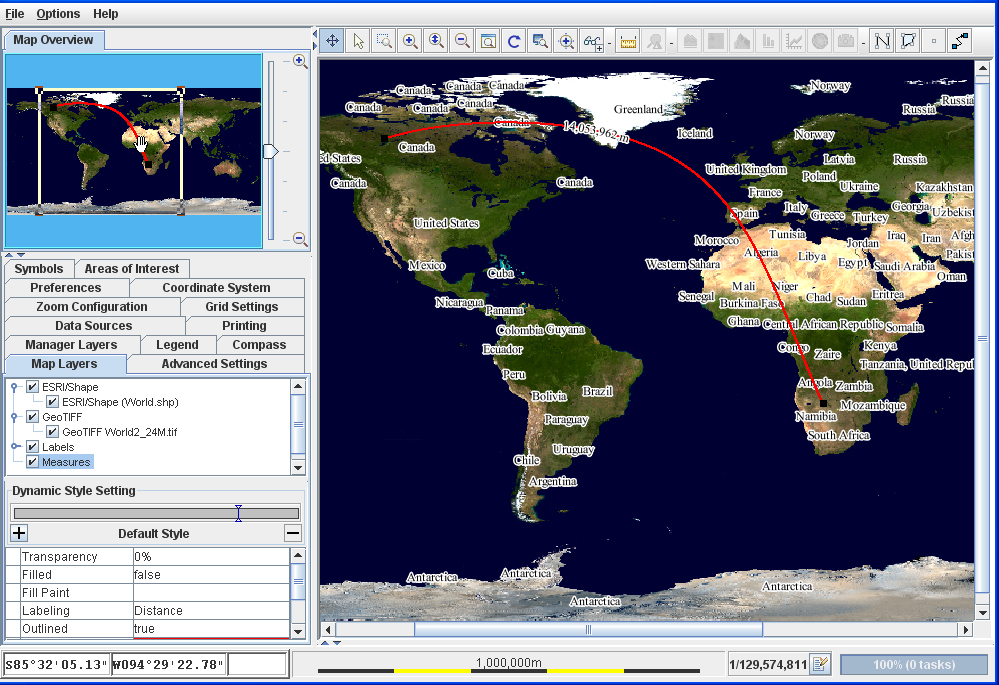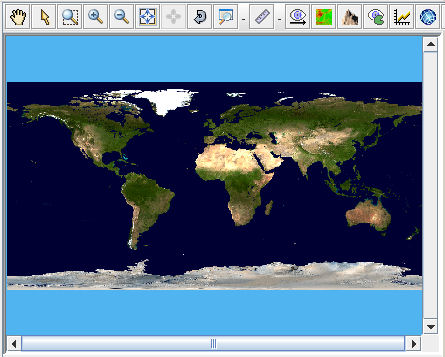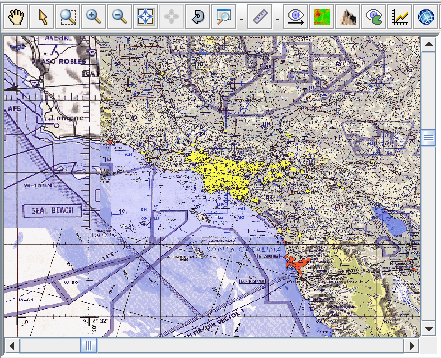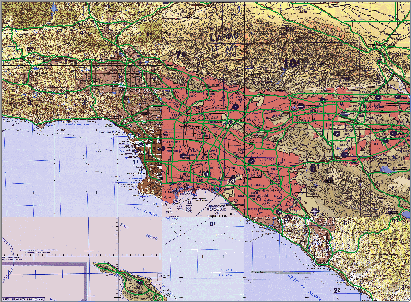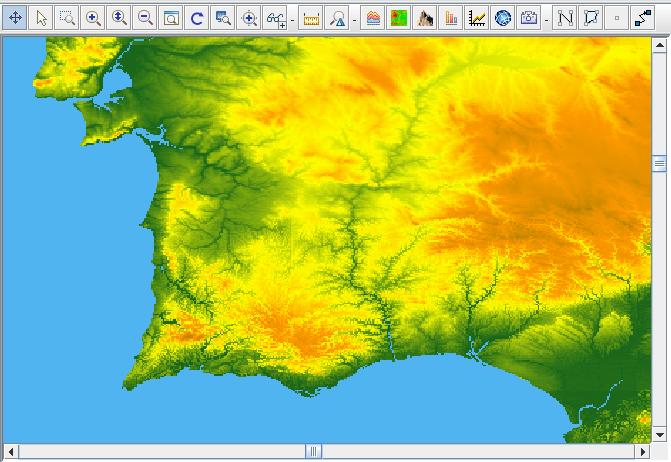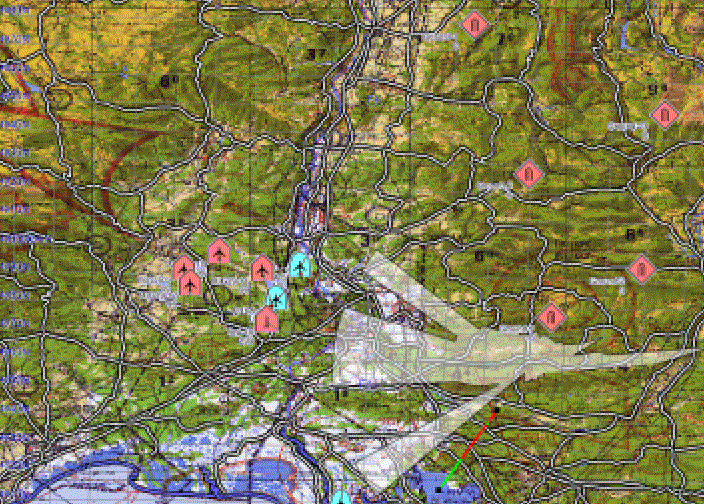Typical uses of JViews Maps for Defense
Gives examples of use of JViews Maps for Defense.

Describes the application fields of
JViews Maps for Defense.

Gives general tips for using
JViews Maps for Defense.

Describes typical actions when creating maps.
Overview
JViews Maps for Defense can manage accurate map data and projections for demanding defense applications such as
C4I and
C4ISR applications. Such applications need to combine map data coming from various sources — military maps, civilian maps, scanned maps — to display the operations.
There are separate scenarios:
General use
JViews Maps for Defense can manage accurate map data and projections for asset mapping applications. Such applications need to combine map data coming from various sources to display the operations.
JViews Maps for Defense has the flexibility and high performance necessary for fast response time. Typically, you would want to read in the map data, create a map
theme and then place and animate symbols on the background map. You can use your own predefined theme and apply it to different sets of data.
In the Map Builder, you can read the data and apply the theme in an easy-to-use point-and-click editor. You can also save your map application, making the configuration settings persistent. Data and theme can be saved separately.
Mission preparation
JViews Maps for Defense has the flexibility and high performance necessary for the fast response time that is critical for mission planning systems. Typically, mission preparation consists of reading in the map data, creating a map
theme. You can use your own predefined theme and apply it to different sets of data.
In the Map Builder, you can these actions, reading the data, applying the theme, and placing military resources in an easy-to-use point-and-click editor.
You can also save your map application, making the configuration settings persistent. Data and theme can be saved separately.
Typical actions
Reading the Data
You import different data sources into a map to provide different views of the data contained in the map. Each data source is associated with a different map layer.
For example, you might start with a shape file, to provide an uncomplicated view of the world as a backdrop.
World map in an application
Then you could refine the esthetic representation of the map by importing a
GeoTIFF format map of the world.
World map in GeoTIFF format
You can add defense information about bases, topography, and military corridors in a selected region by importing a map in
CADRG format.
Data source in CADRG format representing areas in California
Then you might add a pure VMAP (see
VMAP format) vector defense map of a specific region, such as North America, for example
vmaplv0\noamer.
Vector defense map in VMAP format
Terrain Analysis detail, such as altitude information, can be added from a data source in GTPO30 format.
Elevation detail from data source for Terrain Analysis
Street level views can be added from
GeoTIFF format and ESRI/
Shapefile format data sources.
Street data in Los Angeles from an ESRI/Shape data source
An example of the series of typical data source types outlined here can be found in
An example map in
Using the Map Builder.
That particular example is based on North America and Los Angeles in particular, but you could equally well import your own data sources for say Iraq and al-Haditha or Basra, or Afghanistan and Kandahar.
JViews Maps for Defense is supplied with the Map Data disk, which includes general map formats that can be distributed free.
Themes and styling
For each map layer you can decide its look and feel in terms of its color, thickness transparency, and so on, and you can define settings for specific zoom levels so that the look and feel changes when users zoom in and out. The look and feel of each layer and its zoom triggers represent a map theme. This is used to visualize only meaningful information for each context.
Placing symbols
JViews Maps for Defense provides a library of
APP-6a (NATO) symbols. This library allows you to place standard APP6a:2525B symbols on a map. You can also add any user-defined symbols to a map. Symbols are created using the Symbol Editor and added to maps using the Designer for
JViews Diagrammer.
You can then load the Designer project file that contains the background map developed with the Map Builder and the Symbols added with the Designer, and load it into your application. For more information about symbols, see the JViews Diagrammer document Developing with design tools>Using the Symbol Editor.
Placing defense symbols
You can add symbol groups to contain symbols that represent items of different types of warfare unit or equipment. The symbols conform to the
APP-6a Standard used by NATO.
NATO Symbol Manager, Types of Symbol
Depending on the type of warfare selected and the type of unit or equipment, you are offered a set of properties to describe the object.
JViews Maps for Defense places the
APP-6a symbol corresponding to the property definition in the position on the map specified in Latitude and Longitude coordinates by the
Location property.
NATO Symbol Manager, Symbol Properties
Placing military resources
Equipment and troop placement are extremely important. The Terrain Analysis features are designed to depict topographic data accurately. With a few mouse clicks, you can create a Line of Sight image to check whether troops and equipment are correctly positioned.
Mission preparation with APP-6a symbols and Line of Sight
The Tools for the job
Rogue Wave® provides a sample application, the Map Builder, that includes the data reading and writing facilities and the layer styling facilities for building
theme in a point-and-click editor. The sample code is accessible and you can easily customize it.
The product also includes the Designer for JViews Diagrammer. The Designer is a point-and-click editor used for writing style rules that control the styling of nodes on the map.
You can switch easily between these tools to hone your application. Typically, you use the Map Builder to speed up application development time by reading in the data sources in different formats and then creating the map theme by styling the layers. Then you would switch to the Designer to write style rules to change the appearance of nodes depending on certain conditions and to design symbols to represent nodes on the map.
For NATO symbols, you can choose from the standard military symbol library,
APP-6a in the Map Builder.
If you need more than these easy-to-use GUIs have to offer, there is a full-featured SDK for refining and customizing your application. In addition to the general mapping API of JViews Maps for Defense, you have access to the Styling and Data Mapping (SDM) package of the JViews Diagrammer API for the styling of nodes to place on a background map, and the whole of the JViews Framework API with its powerful graphics framework. You have full control over what you do.
Mission execution
With today’s battlefield technology, you can use prepared maps updated in real time with live streamed data. The prepared maps can be streamed by satellite to a notebook in a military vehicle. Up-to-date photographic data can be transmitted from Unmanned Aerial Vehicles (
UAV). You can have real-time data feed from PDAs in the field. Data from the Global Positioning System (
GPS) can also be streamed and displayed on the notebook.
One could even imagine a situation where every soldier has a life sensor for transmitting data to the notebook in the mobile command center and the symbols on the map could reflect the position of the troops moving in real time and their losses.
Key Strengths of JViews Maps for Defense
In the application, the up-to-date data can be displayed against the background map with the appropriate symbols correctly positioned.
The key strengths of JViews Maps for Defense make it ideal for asset-mapping applications.

Components, such as beans, readers, map displays, and map views, are easily customizable to adapt to your needs. Your existing system architecture can be maintained.

Performance allows for almost instantaneous zooming in and out and the system can manage huge amounts of data.

Animated symbols can show the movement of resources on the map.
In addition, with JViews Maps for Defense animated symbols can show the movement of adversaries and the defense features provided with Terrain Analysis make JViews Maps for Defense ideal for use in battlefield scenarios.

Terrain analysis gives you sophisticated features to make your battlefield intelligence more relevant:

Cross-sections

Line of Sight

3D View

Fly Through

Area of Sight

Gradients

Area detection
Since the map data and the map theme can be saved separately, the map theme can be used to style maps for different regions so that they have the same color scheme and visual properties. The final user can then reuse this theme and apply it to the appropriate data source at run time.
When the missions take place, the field officer can select the basic map data or the latest satellite images and navtech data and apply the theme with the appropriate GeoTIFF and Shape files.
Map applications built with JViews Maps for Defense can be an essential part of a decision support center whether on or off the battlefield.
Copyright © 2018, Rogue Wave Software, Inc. All Rights Reserved.
